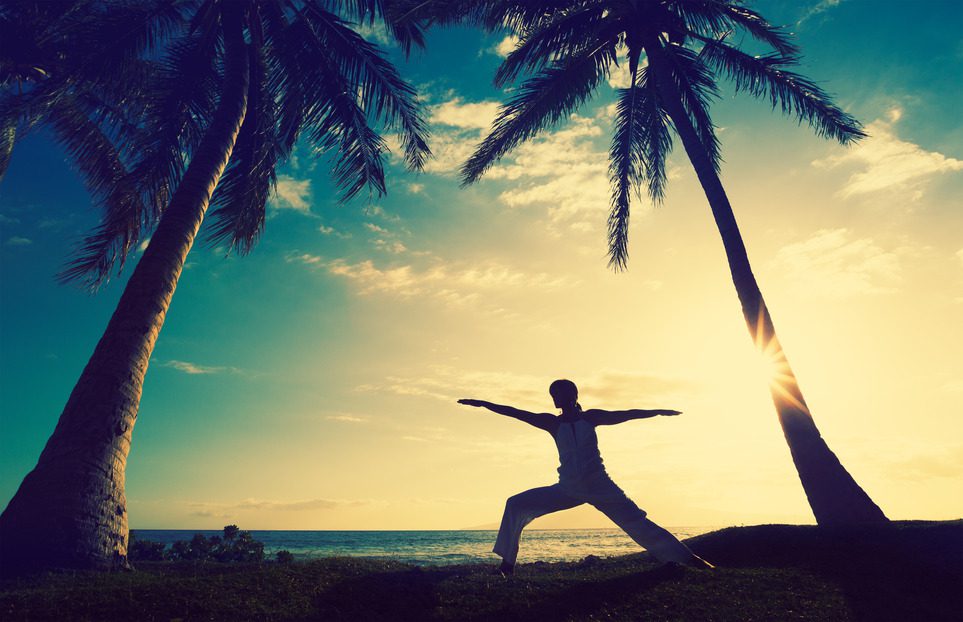“Yoga, an ancient but perfect science, deals with the evolution of humanity. This evolution includes all aspects of one’s being, from bodily health to self-realization. Yoga means union – the union of body with consciousness and consciousness with the soul. Yoga cultivates the ways of maintaining a balanced attitude in day to day life and endows skill in the performance of one’s actions.” – B.K.S. Iyengar
The above quote manages to capture the essence of yoga. The person from whom this quote came, B.K.S. Iyengar, was a legendary practitioner and teacher of yoga. Iyengar lived a healthy 95 years. And, during that time, his teachings and philosophies became the core of how yoga is taught. Additionally, he is the individual we credit with bringing the practice of Yoga to the Western world.
An overview of Yoga
The word ‘yoga’ means ‘union’, with the intention of bringing together the individual consciousness with the Universal Consciousness or spirit. Most people know that yoga involves a series of stretching and poses. However, yoga’s purpose is much, much deeper. There are many different teachings, all of which constitute the overall experience of the practitioner:
– Hatha Yoga: a system consisting of various physical postures, with the purpose of purifying the body. Yogis teach individual awareness and control over the mind along with the physical aspects.
– Mantra Yoga: the centering of consciousness by repeating certain sounds meant to represent a specific aspect of the Spirit.
– Karma Yoga: the practice of devoting oneself to the service of others without attachment or expectation of reward.
– Jnana Yoga: the path which emphasizes wisdom and the use of discriminative intelligence to achieve spiritual liberation.
– Bhakti Yoga: all-surrendering devotion and love to every living being, including nature.
What science proves
The practice of this discipline has been around for centuries – nearly 5,000 years. Yoga, as with mindfulness meditation, is becoming infamous for its many benefits to the practitioner. Many experts believe that these benefits are derived from one core element – the chemical changes in the brain that meditation produces.
Yoga and brain chemistry
In a study done at Boston University, researchers discovered something very interesting. Scientists scanned the brains of 19 participants, consisting of eight long-time yoga practitioners and 11 non-practitioners. The brain scans utilized state-of-the-art magnetic resonance spectroscopic imaging to measure to levels of the neurotransmitter gamma-aminobutyric acid (GABA) – known to be a primary brain chemical deficient in those suffering from depression and anxiety.
The scans were taken before the beginning of the experiment. After which, the yoga group engaged in a 60-minute yoga session while the other group read. Researchers than re-scanned the 19 participants.
“We showed a 27 percent increase in the brain GABA levels of those doing yoga – a really significant increase” said Dr. Chris Streeter, professor of psychiatry and neurology at Boston University School of Medicine. The 11 participants who simply read did not register any kind of GABA-level change.
“I think what’s important about this study is that it shows that by using really cutting-edge neuroimaging technology, we can measure real changes in the brain with behavioral interventions – changes that are similar to those that we see what pharmacologic treatments.” Dr. Streeter notes. Dr. Streeter concluded that other meditative-type practices could produce similar results.
Yoga and ‘emotional distress’
It is thought that this exercise is effective in counteracting or preventing depression and anxiety because the practice moderates stress response systems. As a result, it reduces physiological symptoms of disorders like high blood pressure and elevated heart rate. Evidence also exists that yoga effectively increases what is known as ‘heart rate variability’ – an indication of the body’s ability to effective manage stress.
Researchers at the University of Duisburg-Essen in Germany wanted to conduct a comprehensive experiment to test yoga’s ability to ease emotional distress. The experiment consisted of 24 women – all who had experienced prevalent symptoms of stress, anxiety and depression. Half of the women took two 90-minute yoga sessions a week for three months. The other half continued their normal routine did no type of stress reduction or exercise program during the test period.
At the conclusion of the study, the women in the yoga group reported significant improvements in perceived stress – anxiety, depression, energy, fatigue and well-being. Overall wellbeing scores improved by 65%; while anxiety scores improved by 30% and depression scores by 50%.
Yoga and PTSD
Officially classified as a severe anxiety disorder, Post-Traumatic Stress Disorder (PTSD) causes many of the same physiological symptoms as those who suffer anxiety and depressive disorders. As such, researchers wanted to find out what effect, in any, that yoga would have on PTSD patients.
Vietnam War veterans, along with veterans from other wars, continue to struggle with PTSD. In one study, researchers undertook an experiment to determine the effects, if any, that Sudarshan Kriya Yoga (SKY) would have on lessening the symptoms of PTSD treatment-resistant Vietnam Veterans.
To test the premonition, researchers chose 50 male Vietnam veterans for the study. Qualified participants took a pre-experiment Clinician-Administered PTSD Scale (CAPS) assessment which tests the severity of PTSD symptoms in the individual. Researchers immediately placed 31 veterans into a SKY intervention program. However, they delayed treating the others for six weeks to form the control group (non-testing group) for the experiment.
The program consisted of 22 hours of guided group yoga instruction covering 5 days. The program proceeded to a 2-hour group yoga session held weekly for the first month, and for once a month thereafter for five months.
The scientists gave the CAPS assessment at pre-intervention, 6-weeks post-intervention, and at a 6-month follow-up. They later gave additional questionnaires to measure alcohol consumption, depression, PTSD and quality of life. Those that participated in the program showed significant improvement in CAPS scores, while there was no change in the non-testing group.
The group that did not test was then enrolled in the SKY program and experienced very similar benefits to the first group. Both groups then had a followup at the six-month timeframe and the benefits were well-maintained during the time period.
Final Thoughts on Yoga to Treat Depression
It astonishes many that ancient practices – such as yoga and mindfulness meditation – are showing scientific validity for their claims. Scientists are an inherently difficult group of people to convince, but as results like these are being demonstrated time and time again, the skeptics continue to fall by the wayside.
Perhaps B.K.S. Iyengar was absolutely right when he says that “Yoga is an ancient but perfect science.”
The legend of yoga has certainly been right about everything else.













